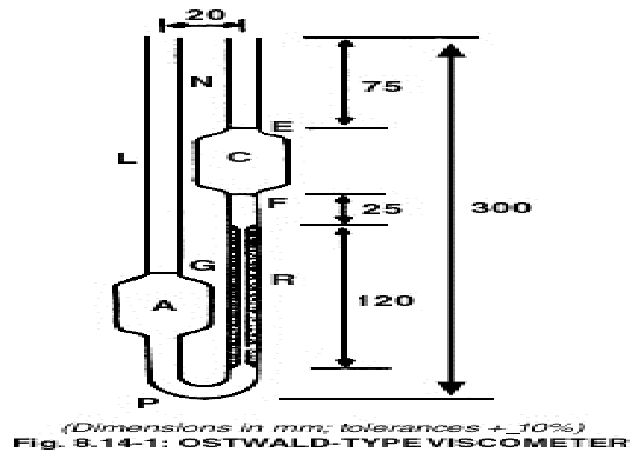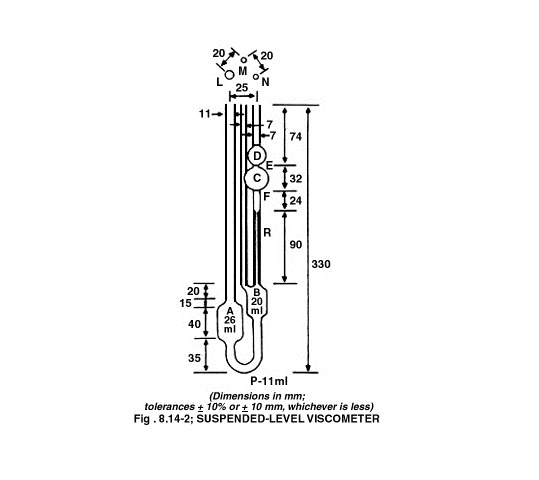Title: Determination of Conductivity
- Objective: To determine the Conductivity of the solution.
- Principle: The electrical conductivityof a solution of an electrolyte is measured by determining the resistance of the solution between two flat or cylindrical electrodes separated by a fixed distance.
The current I (in amperes) flowing in a conductor is directly proportional to the applied electromotive force E (in volts) and inversely proportional to the resistance R (in ohms) of the conductor.
Current (I) = E/R
3. Procedure:
- Definitions:
- Conductivity: Conductivity of the solution (K) is the reciprocal of resistivity (p) which is defined as the quotient of the electric field and the density of the current (flowing in the conducting solution). The unit of conductivity in the International System is the Siemens per metre (Sm-1). Generally used in expressing the electrical conductivity is siemens per centimetre (Scm-1) or microsiemens per centimetre (μScm-1).
- Apparatus:
The apparatus used is a Conductivity Meter that measures the resistance of the column of liquid between the electrodes of the immersed conductivity cell. For operation and calibration of Conductivity Meter refer respective SOP.
- Method:
After the Conductivity Meter has been calibrated with a certified reference material solution, rinse the conductivity cell several times with purified water and atleast twice with aqueous solution under examination. Carry out the successive measurements as described in the individual monograph.
- Procedure for Water Conductivity:
A three stage method of testing is described for Purified Water and Water for Injection Testing. Testing at first stage is usually adequate for Purified Water.
Stage 1: It is intended for online measurement or may be performed offline in a suitable container.
- Measure the temperature of the water and the conductivity of the water using a non temperature-compensated conductivity reading.
- Using theTable 1—Temperature and Conductivity Requirements table, find the temperature value that is not greater than the measured temperature, and read the corresponding conductivity value that becomes the limit.
- If the measured conductivity is not greater than the table value, the water meets the requirements of the test for conductivity. If the conductivity is higher than the table value, proceed with Stage 2.
Table 1—Temperature and Conductivity Requirements
(for non temperature-compensated conductivity reading only)
| Temperature(°) | Purified Water Conductivity (µS/cm) | Water for Injections and sterile water for Inhalation Conductivity (µS/cm) |
| 0 | 2.4 | 0.6 |
| 5 | – | 0.8 |
| 10 | 3.6 | 0.9 |
| 15 | – | 1.0 |
| 20 | 4.3 | 1.1 |
| 25 | 5.1 | 1.3 |
| 30 | 5.4 | 1.4 |
| 35 | 2.4 | 1.5 |
| 40 | 1.7 | 6.5 |
| 45 | 1.8 | – |
| 50 | 1.9 | 7.1 |
| 55 | 2.1 | – |
| 60 | 8.1 | 2.2 |
| 65 | – | 2.4 |
| 70 | 9.1 | 2.5 |
| 75 | 9.7 | 2.7 |
| Temperature(°) | Purified Water Conductivity (µS/cm) | Water for Injections and sterile water for Inhalation Conductivity (µS/cm) |
| 80 | 9.7 | 2.7 |
| 85 | – | 2.7 |
| 90 | 9.7 | 2.7 |
| 95 | – | 2.9 |
| 100 | 10.2 | 3.1 |
Stage 2:
- Transfer a sufficient amount of water (100 ml or more) to a suitable container, and stir the test specimen. Adjust the temperature at 25 ± 1 if necessary, begin vigorously agitating the test specimen while periodically observing the conductivity. When the change in conductivity (due to uptake of atmospheric carbon dioxide) is less than a net of 0.1 µS/cm per 5 minutes, note the conductivity.
- If the conductivity is not greater than 2.1 µS/cm, the water meets the requirements of the test for conductivity. If the conductivity is greater than 2.1 µS/cm, proceed with Stage 3.
Stage 3:
- Perform this test within approximately 5 minutes of the conductivity determination in Step 5, while maintaining the sample temperature at 25 ± 1. Add a recently prepared saturated Potassium Chloride solution to the same water sample (0.3 ml per 100 ml of the test specimen), and determine the pH to the nearest 0.1 pH unit.
- Referring to the Stage 3—pH and Conductivity Requirements table 2, determine the conductivity limit at the measured pH value. If the measured conductivity in Step 4 is not greater than the conductivity requirements for the pH determined in Step 6, the water meets the requirements of the test for conductivity. If either the measured conductivity is greater than this value or the pH is outside the range of 5.0 to 7.0, the water does not meet the requirements of the test for conductivity.
Table 2
| pH | Conductivity Requirement (µS/cm) |
| 5.0 | 4.7 |
| 5.1 | 4.1 |
| 5.2 | 3.6 |
| 5.3 | 3.3 |
| 5.4 | 3.0 |
| 5.5 | 2.8 |
| 5.6 | 2.6 |
| 5.7 | 2.5 |
| 5.8 | 2.4 |
| 5.9 | 2.4 |
| 6.0 | 2.4 |
| 6.1 | 2.4 |
| 6.2 | 2.5 |
| 6.3 | 2.4 |
| 6.4 | 2.2 |
| pH | Conductivity Requirement (µS/cm) |
| 6.5 | 2.2 |
| 6.6 | 2.2 |
| 6.7 | 2.6 |
| 6.8 | 3.1 |
| 6.9 | 3.8 |
| 7.0 | 4.6 |


